QUESTION 1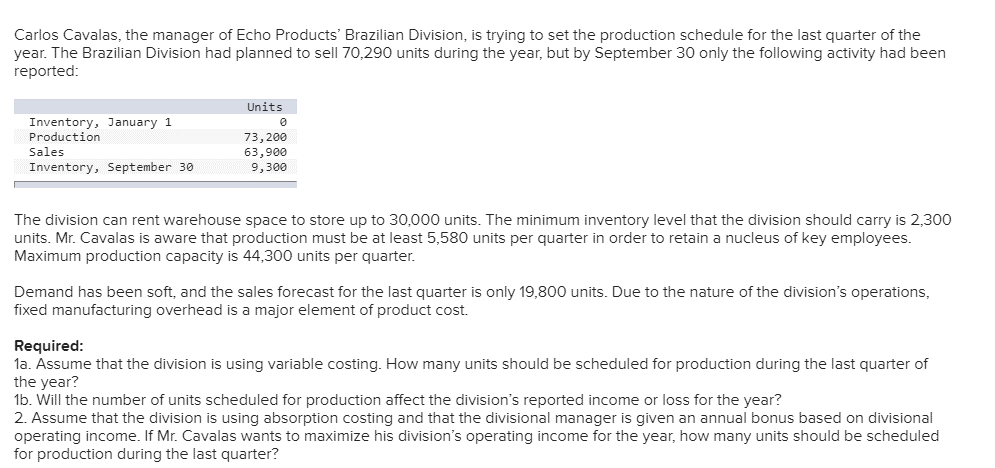



QUESTION 2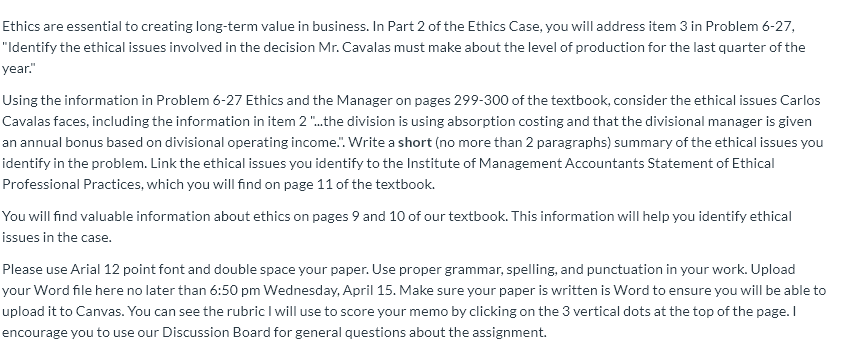
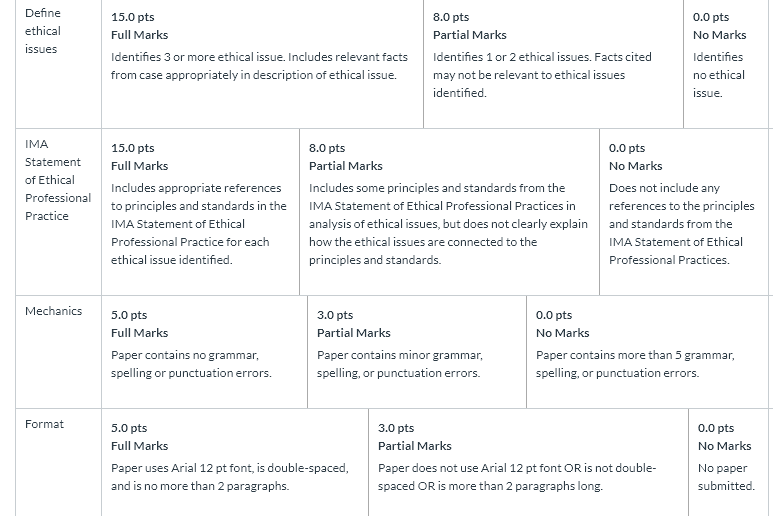
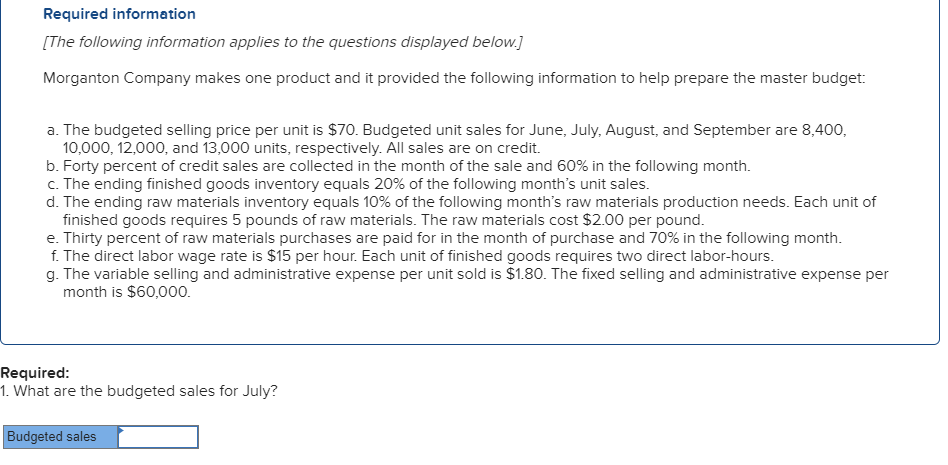
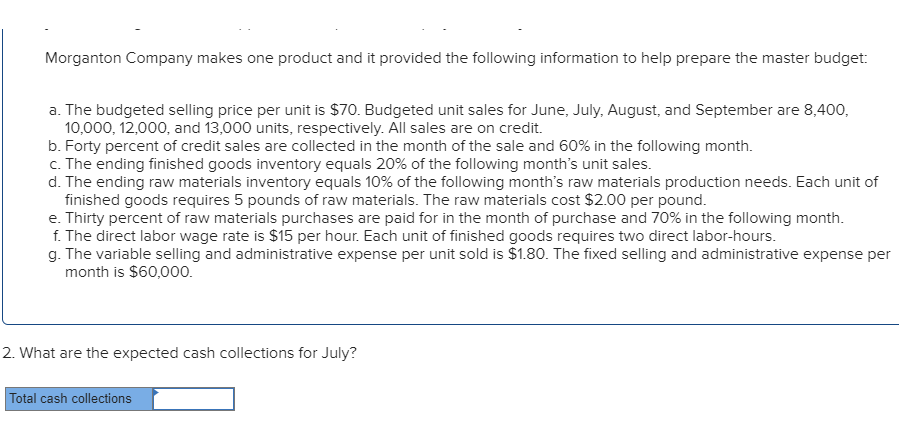

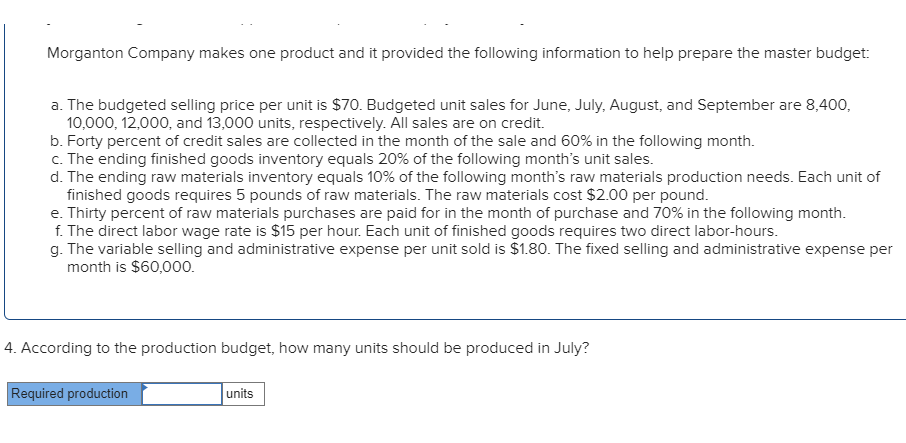
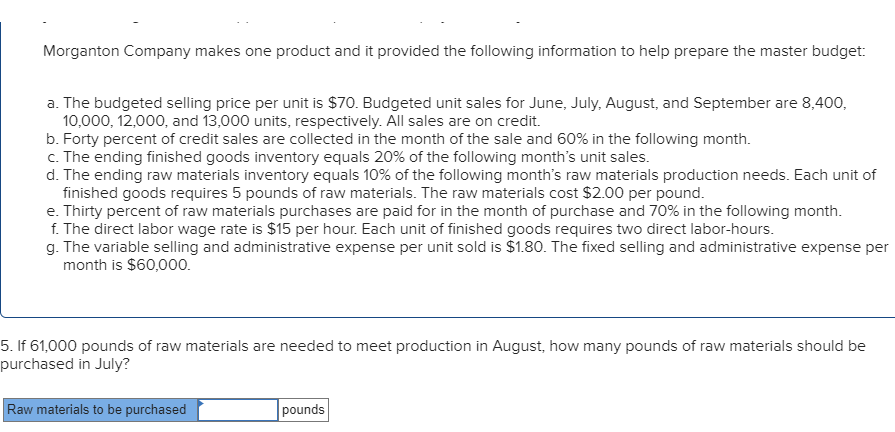
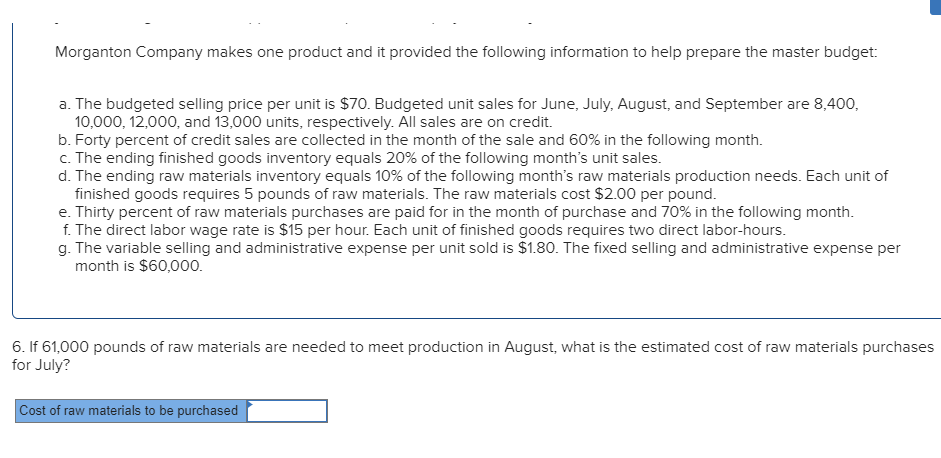
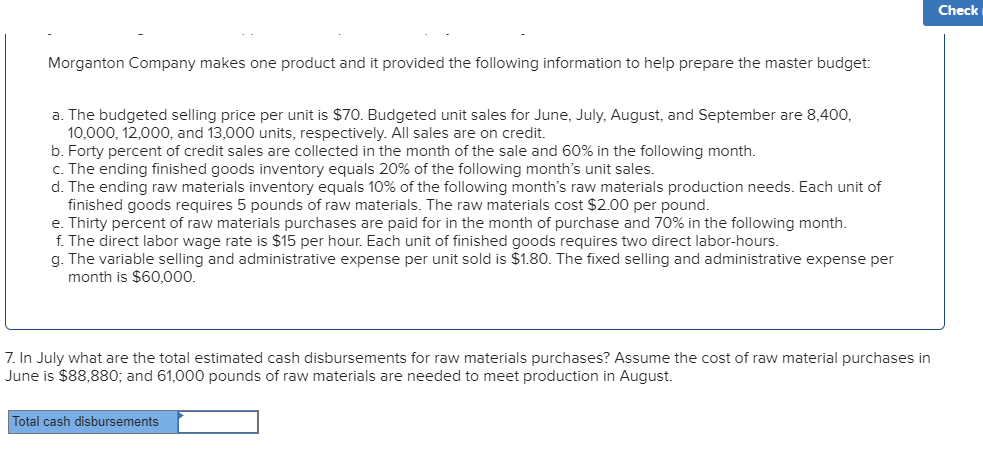
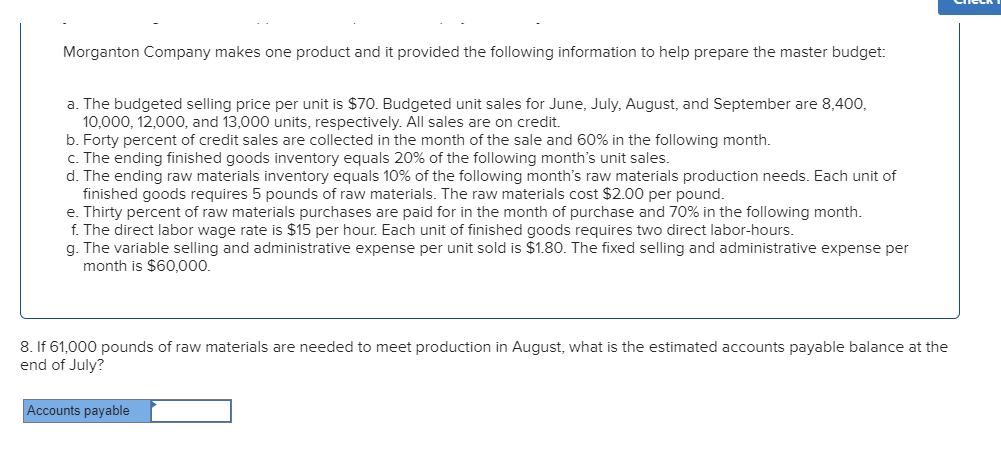

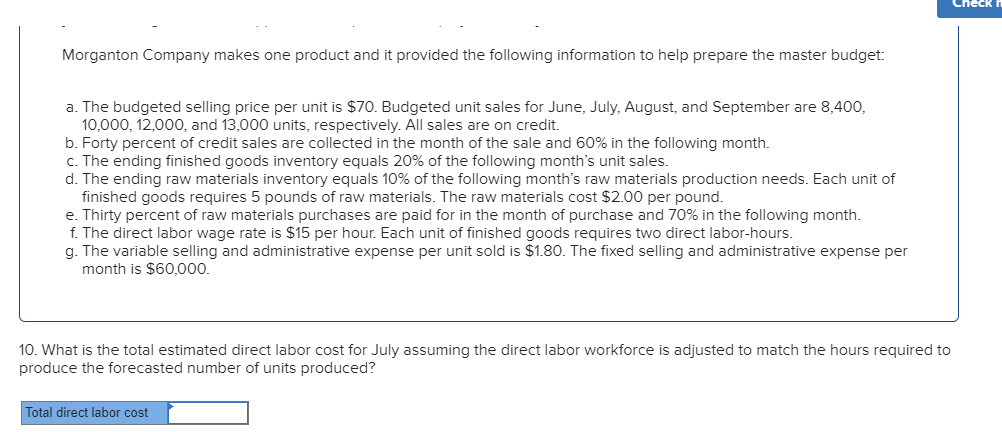
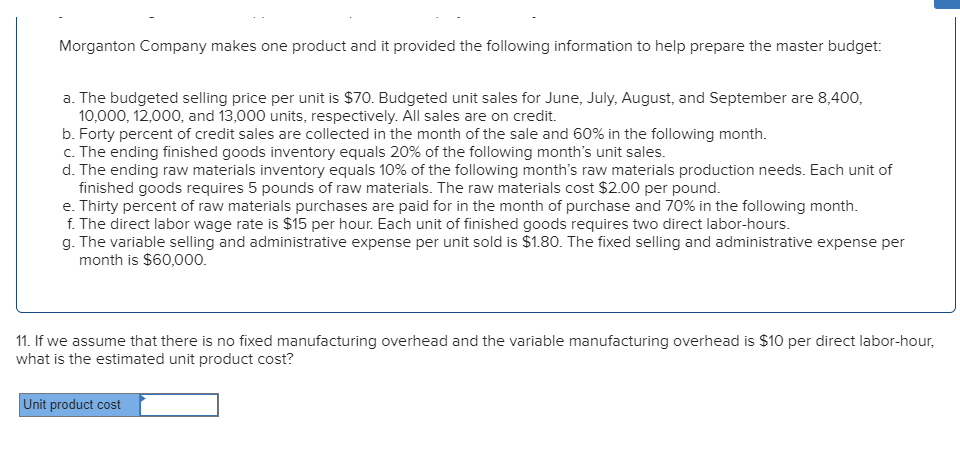
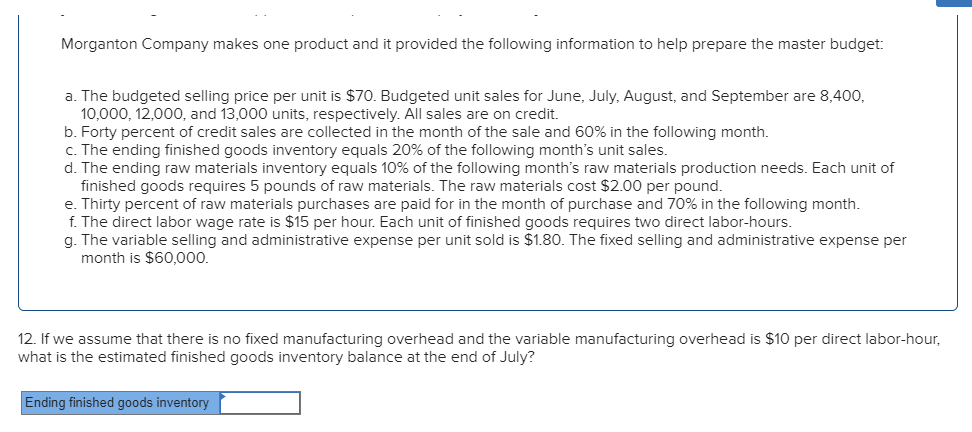
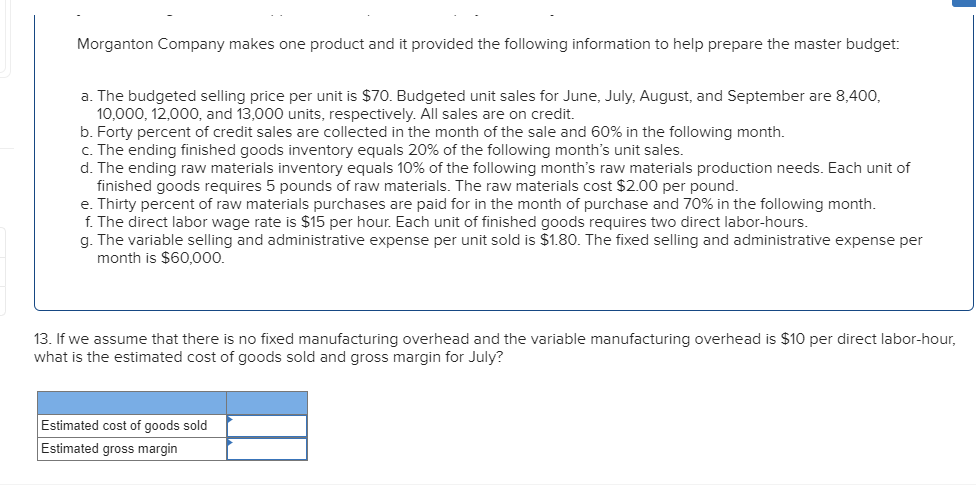
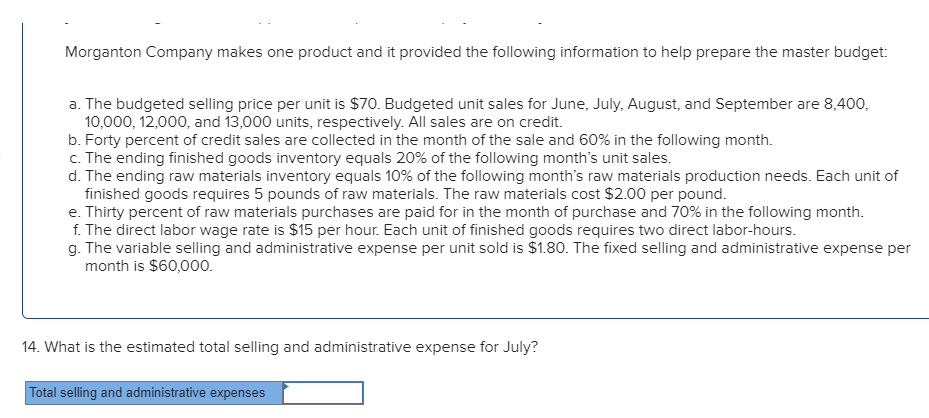
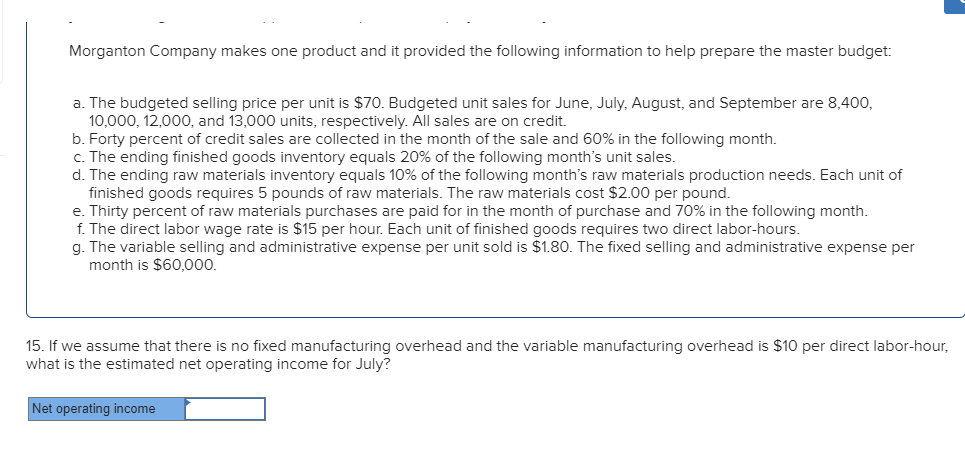
Carlos Cavalas, the manager of Echo Products' Brazilian Division, is trying to set the production schedule for the last quarter of the year. The Brazilian Division had planned to sell 70,290 units during the year, but by September 30 only the following activity had been reported: Units Inventory, January 1 Production Sales Inventory, September 30 73,200 63,900 9,300 The division can rent warehouse space to store up to 30,000 units. The minimum inventory level that the division should carry is 2,300 units. Mr. Cavalas is aware that production must be at least 5,580 units per quarter in order to retain a nucleus of key employees. Maximum production capacity is 44,300 units per quarter. Demand has been soft, and the sales forecast for the last quarter is only 19,800 units. Due to the nature of the division's operations, fixed manufacturing overhead is a major element of product cost. Required: 1a. Assume that the division is using variable costing. How many units should be scheduled for production during the last quarter of the year? 1b. Will the number of units scheduled for production affect the division's reported income or loss for the year? 2. Assume that the division is using absorption costing and that the divisional manager is given an annual bonus based on divisional operating income. If Mr. Cavalas wants to maximize his division's operating income for the year, how many units should be scheduled for production during the last quarter? Complete this question by entering your answers in the tabs below. Reg 1A Reg 1B Reg 2 Assume that the division is using variable costing. How many units should be scheduled for production during the last quarter of the year? Required production units Complete this question by entering your answers in the tabs below. Reg 1A Reg 1B Reg 2 Will the number of units scheduled for production affect the division's reported income or loss for the year? Yes ONO Reg 1A Reg 1B Reg 2 Assume that the division is using absorption costing and that the divisional manager is given an annual bonus based on divisional operating income. If Mr. Cavalas wants to maximize his division's operating income for the year, how many units should be scheduled for production during the last quarter? Required production units Ethics are essential to creating long-term value in business. In Part 2 of the Ethics Case, you will address item 3 in Problem 6-27, "Identify the ethical issues involved in the decision Mr. Cavalas must make about the level of production for the last quarter of the year." Using the information in Problem 6-27 Ethics and the Manager on pages 299-300 of the textbook, consider the ethical issues Carlos Cavalas faces, including the information in item 2 "...the division is using absorption costing and that the divisional manager is given an annual bonus based on divisional operating income.". Write a short (no more than 2 paragraphs) summary of the ethical issues you identify in the problem. Link the ethical issues you identify to the Institute of Management Accountants Statement of Ethical Professional Practices, which you will find on page 11 of the textbook. You will find valuable information about ethics on pages 9 and 10 of our textbook. This information will help you identify ethical issues in the case. Please use Arial 12 point font and double space your paper. Use proper grammar, spelling, and punctuation in your work. Upload your Word file here no later than 6:50 pm Wednesday, April 15. Make sure your paper is written is Word to ensure you will be able to upload it to Canvas. You can see the rubric I will use to score your memo by clicking on the 3 vertical dots at the top of the page. I encourage you to use our Discussion Board for general questions about the assignment. Define ethical issues 15.0 pts Full Marks Identifies 3 or more ethical issue. Includes relevant facts from case appropriately in description of ethical issue. 8.0 pts Partial Marks Identifies 1 or 2 ethical issues. Facts cited may not be relevant to ethical issues identified. 0.0 pts No Marks Identifies no ethical issue. IMA Statement of Ethical Professional Practice 15.0 pts Full Marks Includes appropriate references to principles and standards in the IMA Statement of Ethical Professional Practice for each ethical issue identified. 8.0 pts Partial Marks Includes some principles and standards from the IMA Statement of Ethical Professional Practices in analysis of ethical issues, but does not clearly explain how the ethical issues are connected to the principles and standards. 0.0 pts No Marks Does not include any references to the principles and standards from the IMA Statement of Ethical Professional Practices. Mechanics 5.0 pts Full Marks Paper contains no grammar, spelling or punctuation errors. 3.0 pts Partial Marks Paper contains minor grammar, spelling, or punctuation errors. 0.0 pts No Marks Paper contains more than 5 grammar, spelling, or punctuation errors. Format 5.0 pts Full Marks Paper uses Arial 12 pt font, is double-spaced, and is no more than 2 paragraphs. 3.0 pts Partial Marks Paper does not use Arial 12 pt font OR is not double- spaced OR is more than 2 paragraphs long. 0.0 pts No Marks No paper submitted. Required information [The following information applies to the questions displayed below.) Morganton Company makes one product and it provided the following information to help prepare the master budget: a. The budgeted selling price per unit is $70. Budgeted unit sales for June, July, August, and September are 8,400, 10,000, 12,000, and 13,000 units, respectively. All sales are on credit. b. Forty percent of credit sales are collected in the month of the sale and 60% in the following month. c. The ending finished goods inventory equals 20% of the following month's unit sales. d. The ending raw materials inventory equals 10% of the following month's raw materials production needs. Each unit of finished goods requires 5 pounds of raw materials. The raw materials cost $2.00 per pound. e. Thirty percent of raw materials purchases are paid for in the month of purchase and 70% in the following month. f. The direct labor wage rate is $15 per hour. Each unit of finished goods requires two direct labor-hours. g. The variable selling and administrative expense per unit sold is $1.80. The fixed selling and administrative expense per month is $60,000. Required: 1. What are the budgeted sales for July? Budgeted sales Morganton Company makes one product and it provided the following information to help prepare the master budget: a. The budgeted selling price per unit is $70. Budgeted unit sales for June, July, August, and September are 8,400, 10,000, 12,000, and 13,000 units, respectively. All sales are on credit. b. Forty percent of credit sales are collected in the month of the sale and 60% in the following month. c. The ending finished goods inventory equals 20% of the following month's unit sales. d. The ending raw materials inventory equals 10% of the following month's raw materials production needs. Each unit of finished goods requires 5 pounds of raw materials. The raw materials cost $2.00 per pound. e. Thirty percent of raw materials purchases are paid for in the month of purchase and 70% in the following month. f. The direct labor wage rate is $15 per hour. Each unit of finished goods requires two direct labor-hours. g. The variable selling and administrative expense per unit sold is $1.80. The fixed selling and administrative expense per month is $60,000. 2. What are the expected cash collections for July? Total cash collections Morganton Company makes one product and it provided the following information to help prepare the master budget: a. The budgeted selling price per unit is $70. Budgeted unit sales for June, July, August, and September are 8,400, 10,000, 12,000, and 13,000 units, respectively. All sales are on credit. b. Forty percent of credit sales are collected in the month of the sale and 60% in the following month. c. The ending finished goods inventory equals 20% of the following month's unit sales. d. The ending raw materials inventory equals 10% of the following month's raw materials production needs. Each unit of finished goods requires 5 pounds of raw materials. The raw materials cost $2.00 per pound. e. Thirty percent of raw materials purchases are paid for in the month of purchase and 70% in the following month. f. The direct labor wage rate is $15 per hour. Each unit of finished goods requires two direct labor-hours. g. The variable selling and administrative expense per unit sold is $1.80. The fixed selling and administrative expense per month is $60,000. 3. What is the accounts receivable balance at the end of July? Accounts receivable Morganton Company makes one product and it provided the following information to help prepare the master budget: a. The budgeted selling price per unit is $70. Budgeted unit sales for June, July, August, and September are 8,400, 10,000, 12,000, and 13,000 units, respectively. All sales are on credit. b. Forty percent of credit sales are collected in the month of the sale and 60% in the following month. c. The ending finished goods inventory equals 20% of the following month's unit sales. d. The ending raw materials inventory equals 10% of the following month's raw materials production needs. Each unit of finished goods requires 5 pounds of raw materials. The raw materials cost $2.00 per pound. e. Thirty percent of raw materials purchases are paid for in the month of purchase and 70% in the following month. f. The direct labor wage rate is $15 per hour. Each unit of finished goods requires two direct labor-hours. g. The variable selling and administrative expense per unit sold is $1.80. The fixed selling and administrative expense per month is $60,000. 4. According to the production budget, how many units should be produced in July? Required production units Morganton Company makes one product and it provided the following information to help prepare the master budget: a. The budgeted selling price per unit is $70. Budgeted unit sales for June, July, August, and September are 8,400, 10,000, 12,000, and 13,000 units, respectively. All sales are on credit. b. Forty percent of credit sales are collected in the month of the sale and 60% in the following month. c. The ending finished goods inventory equals 20% of the following month's unit sales. d. The ending raw materials inventory equals 10% of the following month's raw materials production needs. Each unit of finished goods requires 5 pounds of raw materials. The raw materials cost $2.00 per pound. e. Thirty percent of raw materials purchases are paid for in the month of purchase and 70% in the following month. f. The direct labor wage rate is $15 per hour. Each unit of finished goods requires two direct labor-hours. g. The variable selling and administrative expense per unit sold is $1.80. The fixed selling and administrative expense per month is $60,000. 5. If 61,000 pounds of raw materials are needed to meet production in August, how many pounds of raw materials should be purchased in July? Raw materials to be purchased pounds Morganton Company makes one product and it provided the following information to help prepare the master budget: a. The budgeted selling price per unit is $70. Budgeted unit sales for June, July, August, and September are 8,400, 10,000, 12,000, and 13,000 units, respectively. All sales are on credit b. Forty percent of credit sales are collected in the month of the sale and 60% in the following month. c. The ending finished goods inventory equals 20% of the following month's unit sales. d. The ending raw materials inventory equals 10% of the following month's raw materials production needs. Each unit of finished goods requires 5 pounds of raw materials. The raw materials cost $2.00 per pound. e. Thirty percent of raw materials purchases are paid for in the month of purchase and 70% in the following month. f. The direct labor wage rate is $15 per hour. Each unit of finished goods requires two direct labor-hours. g. The variable selling and administrative expense per unit sold is $1.80. The fixed selling and administrative expense per month is $60,000. 6. If 61,000 pounds of raw materials are needed to meet production in August, what is the estimated cost of raw materials purchases for July? Cost of raw materials to be purchased Check Morganton Company makes one product and it provided the following information to help prepare the master budget: a. The budgeted selling price per unit is $70. Budgeted unit sales for June, July, August, and September are 8,400, 10,000, 12,000, and 13,000 units, respectively. All sales are on credit. b. Forty percent of credit sales are collected in the month of the sale and 60% in the following month. c. The ending finished goods inventory equals 20% of the following month's unit sales. d. The ending raw materials inventory equals 10% of the following month's raw materials production needs. Each unit of finished goods requires 5 pounds of raw materials. The raw materials cost $2.00 per pound. e. Thirty percent of raw materials purchases are paid for in the month of purchase and 70% in the following month. f. The direct labor wage rate is $15 per hour. Each unit of finished goods requires two direct labor-hours. g. The variable selling and administrative expense per unit sold is $1.80. The fixed selling and administrative expense per month is $60,000. 7. In July what are the total estimated cash disbursements for raw materials purchases? Assume the cost of raw material purchases in June is $88,880, and 61,000 pounds of raw materials are needed to meet production in August. Total cash disbursements Morganton Company makes one product and it provided the following information to help prepare the master budget: a. The budgeted selling price per unit is $70. Budgeted unit sales for June, July, August, and September are 8,400, 10,000, 12,000, and 13,000 units, respectively. All sales are on credit b. Forty percent of credit sales are collected in the month of the sale and 60% in the following month. c. The ending finished goods inventory equals 20% of the following month's unit sales. d. The ending raw materials inventory equals 10% of the following month's raw materials production needs. Each unit of finished goods requires 5 pounds of raw materials. The raw materials cost $2.00 per pound. e. Thirty percent of raw materials purchases are paid for in the month of purchase and 70% in the following month. f. The direct labor wage rate is $15 per hour. Each unit of finished goods requires two direct labor-hours. g. The variable selling and administrative expense per unit sold is $1.80. The fixed selling and administrative expense per month is $60,000. 8. If 61,000 pounds of raw materials are needed to meet production in August, what is the estimated accounts payable balance at the end of July? Accounts payable Morganton Company makes one product and it provided the following information to help prepare the master budget: a. The budgeted selling price per unit is $70. Budgeted unit sales for June, July, August, and September are 8,400, 10,000, 12,000, and 13,000 units, respectively. All sales are on credit. b. Forty percent of credit sales are collected in the month of the sale and 60% in the following month. c. The ending finished goods inventory equals 20% of the following month's unit sales. d. The ending raw materials inventory equals 10% of the following month's raw materials production needs. Each unit of finished goods requires 5 pounds of raw materials. The raw materials cost $2.00 per pound. e. Thirty percent of raw materials purchases are paid for in the month of purchase and 70% in the following month. f. The direct labor wage rate is $15 per hour. Each unit of finished goods requires two direct labor-hours. g. The variable selling and administrative expense per unit sold is $1.80. The fixed selling and administrative expense per month is $60,000. 9. If 61,000 pounds of raw materials are needed to meet production in August, what is the estimated raw materials inventory balance at the end of July? Raw material inventory balance Check Morganton Company makes one product and it provided the following information to help prepare the master budget: a. The budgeted selling price per unit is $70. Budgeted unit sales for June, July, August, and September are 8,400, 10,000, 12,000, and 13,000 units, respectively. All sales are on credit. b. Forty percent of credit sales are collected in the month of the sale and 60% in the following month. c. The ending finished goods inventory equals 20% of the following month's unit sales. d. The ending raw materials inventory equals 10% of the following month's raw materials production needs. Each unit of finished goods requires 5 pounds of raw materials. The raw materials cost $2.00 per pound. e. Thirty percent of raw materials purchases are paid for in the month of purchase and 70% in the following month. f. The direct labor wage rate is $15 per hour. Each unit of finished goods requires two direct labor-hours. g. The variable selling and administrative expense per unit sold is $1.80. The fixed selling and administrative expense per month is $60,000. 10. What is the total estimated direct labor cost for July assuming the direct labor workforce is adjusted to match the hours required to produce the forecasted number of units produced? Total direct labor cost Morganton Company makes one product and it provided the following information to help prepare the master budget: a. The budgeted selling price per unit is $70. Budgeted unit sales for June, July, August, and September are 8,400, 10.000. 12.000, and 13,000 units, respectively. All sales are on credit. b. Forty percent of credit sales are collected in the month of the sale and 60% in the following month. c. The ending finished goods inventory equals 20% of the following month's unit sales. d. The ending raw materials inventory equals 10% of the following month's raw materials production needs. Each unit of finished goods requires 5 pounds of raw materials. The raw materials cost $2.00 per pound. e. Thirty percent of raw materials purchases are paid for in the month of purchase and 70% in the following month. f. The direct labor wage rate is $15 per hour. Each unit of finished goods requires two direct labor-hours. g. The variable selling and administrative expense per unit sold is $1.80. The fixed selling and administrative expense per month is $60,000. 11. If we assume that there is no fixed manufacturing overhead and the variable manufacturing overhead is $10 per direct labor-hour, what is the estimated unit product cost? Unit product cost Morganton Company makes one product and it provided the following information to help prepare the master budget: a. The budgeted selling price per unit is $70. Budgeted unit sales for June, July, August, and September are 8,400, 10,000, 12,000, and 13,000 units, respectively. All sales are on credit. b. Forty percent of credit sales are collected in the month of the sale and 60% in the following month. c. The ending finished goods inventory equals 20% of the following month's unit sales. d. The ending raw materials inventory equals 10% of the following month's raw materials production needs. Each unit of finished goods requires 5 pounds of raw materials. The raw materials cost $2.00 per pound. e. Thirty percent of raw materials purchases are paid for in the month of purchase and 70% in the following month. f. The direct labor wage rate is $15 per hour. Each unit of finished goods requires two direct labor-hours. g. The variable selling and administrative expense per unit sold is $1.80. The fixed selling and administrative expense per month is $60,000. 12. If we assume that there is no fixed manufacturing overhead and the variable manufacturing overhead is $10 per direct labor-hour, what is the estimated finished goods inventory balance at the end of July? Ending finished goods inventory Morganton Company makes one product and it provided the following information to help prepare the master budget: a. The budgeted selling price per unit is $70. Budgeted unit sales for June, July, August, and September are 8,400, 10,000, 12,000, and 13,000 units, respectively. All sales are on credit. b. Forty percent of credit sales are collected in the month of the sale and 60% in the following month. c. The ending finished goods inventory equals 20% of the following month's unit sales. d. The ending raw materials inventory equals 10% of the following month's raw materials production needs. Each unit of finished goods requires 5 pounds of raw materials. The raw materials cost $2.00 per pound. e. Thirty percent of raw materials purchases are paid for in the month of purchase and 70% in the following month. f. The direct labor wage rate is $15 per hour. Each unit of finished goods requires two direct labor-hours. g. The variable selling and administrative expense per unit sold is $1.80. The fixed selling and administrative expense per month is $60,000. 13. If we assume that there is no fixed manufacturing overhead and the variable manufacturing overhead is $10 per direct labor-hour, what is the estimated cost of goods sold and gross margin for July? Estimated cost of goods sold Estimated gross margin Morganton Company makes one product and it provided the following information to help prepare the master budget: a. The budgeted selling price per unit is $70. Budgeted unit sales for June, July, August, and September are 8,400, 10,000, 12,000, and 13,000 units, respectively. All sales are on credit. b. Forty percent of credit sales are collected in the month of the sale and 60% in the following month. c. The ending finished goods inventory equals 20% of the following month's unit sales. d. The ending raw materials inventory equals 10% of the following month's raw materials production needs. Each unit of finished goods requires 5 pounds of raw materials. The raw materials cost $2.00 per pound. e. Thirty percent of raw materials purchases are paid for in the month of purchase and 70% in the following month. f. The direct labor wage rate is $15 per hour. Each unit of finished goods requires two direct labor-hours. g. The variable selling and administrative expense per unit sold is $1.80. The fixed selling and administrative expense per month is $60,000. 14. What is the estimated total selling and administrative expense for July? Total selling and administrative expenses | Morganton Company makes one product and it provided the following information to help prepare the master budget: a. The budgeted selling price per unit is $70. Budgeted unit sales for June, July, August, and September are 8,400, 10,000, 12,000, and 13,000 units, respectively. All sales are on credit. b. Forty percent of credit sales are collected in the month of the sale and 60% in the following month. c. The ending finished goods inventory equals 20% of the following month's unit sales. d. The ending raw materials inventory equals 10% of the following month's raw materials production needs. Each unit of finished goods requires 5 pounds of raw materials. The raw materials cost $2.00 per pound. e. Thirty percent of raw materials purchases are paid for in the month of purchase and 70% in the following month. f. The direct labor wage rate is $15 per hour. Each unit of finished goods requires two direct labor-hours. g. The variable selling and administrative expense per unit sold is $1.80. The fixed selling and administrative expense per month is $60,000. 15. If we assume that there is no fixed manufacturing overhead and the variable manufacturing overhead is $10 per direct labor-hour, what is the estimated net operating income for July? Net operating income



























